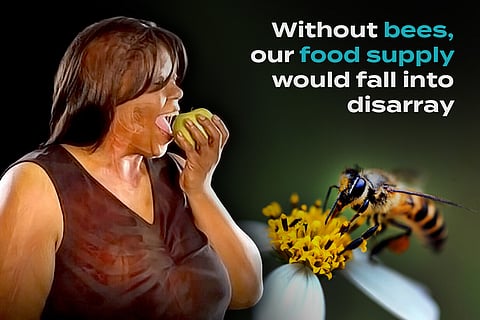Bridging the Gap - Health Equity for all
Without Bees, We Wouldn’t Have Apples, Almonds, or Avocados
<p>Tiny but mighty, the humble bee plays a colossal role in sustaining life on Earth. They buzz around the place doing their thing, but the significance of bees goes far beyond their size. From pollinating crops to producing honey, bees are vital for food security and human health, but they are under threat. It’s no wonder you’ve probably come across a “Save the Bees” t-shirt or two.</p>
<p>Below is a rundown of their importance and why they’re under threat.</p>
<h2>What’s the buzz with bees?</h2>
<p>There are around 20,000 species of bees worldwide, and over 3,600 have a home in the US. We only manage a few of these species, as most are wild. </p>
<p>Honeybees are money-making machines for US agriculture. These hardworking insects produce six important products from their hives: honey, pollen, royal jelly, beeswax, propolis, and venom, all of which are used for an array of nutritional and medicinal purposes.</p>
<figure><img alt height="334" src="https://cdn.storymd.com/optimized/kAvNXLUeA1/original.jpg" width="500" />
<figcaption>Honey Bees, Beehive, Honey <em>Source: PollyDot/Pixabay</em></figcaption>
</figure>
<h3>Crop pollination</h3>
<p>Bees are important in so many ways, but one stands out above them all: crop pollination. </p>
<p>Pollination happens when bees and other pollinators move from one plant to the next, fertilizing them along the way with pollen deposits. Bees are hairy for a reason: it attracts pollen, so when a flower’s pollen sticks to a bee, it travels with the little fellow to the next plant or flower. The pollen is then distributed, resulting in cross-pollination, which ultimately yields fruits, vegetables, and seeds.</p>
<figure><img alt height="334" src="https://cdn.storymd.com/optimized/Qd9OJgIgAg/original.jpg" width="500" />
<figcaption>Honey Bee Covered in Pollen <em>Source: CNX Openstax (credit: modification of work by Jon Sullivan)</em></figcaption>
</figure>
<h3>Flying ahead in pollen distribution</h3>
<p>Bees are simply one of the most important pollinators in the world for food crops, and we rely on them every day to do their job. One out of every three food bites you take relies on pollination, but bee populations continue to plummet because of the rampant use of pesticides, increasing urbanization, and climate change. Bees are critical to sustaining our societies and health along with that of the overall environment. </p>
<h3>Bees feed America</h3>
<p>Honeybees are not native to the US, and neither are most of the crops grown here. Both the crops and bees evolved together in other parts of the world and were then brought here by European settlers, perhaps as early as 1622.</p>
<p>More than 90 commercial crops rely on bee pollination, and of the 3,600 or so species that live in the US, the European honeybee is the most common pollinator. We can thank them for putting diverse and nutritious foods on our dinner tables, such as apples, pumpkins, squash, broccoli, melons, cranberries, and almonds. </p>
<h3>We need bees for food security</h3>
<p>Without the pollination services of bees, many crops would yield a fraction of a typical harvest, cutting the availability of essential foods and jacking up the prices. The diversity of our diets would suffer as many fruits and vegetables would become scarce or nonexistent. The effect of declining bee populations in global agricultural hotspots (“breadbaskets of the world”) could be catastrophic for food production and livelihoods.</p>
<h2>Bees in medicine and other areas</h2>
<p>Bees and their related products have been used in medicine for thousands of years, and research has noted antioxidant, antimicrobial, and anti-inflammatory properties. For example, among bee venom’s components is a protein called melittin, which has a potent anti-inflammatory action.</p>
<h3>Honey</h3>
<p>Honey has been used in traditional medicine for all sorts of conditions. Although many applications do not have scientific backing, honey has been used to treat tuberculosis, throat infections, eye diseases, eczema, and many more. The golden elixir of honey is rich in antioxidants, vitamins, and minerals, which garnered its reputation as a remedy for all sorts of ailments. Honey has been used as a wound dressing for thousands of years due to its ability to accelerate and improve healing.</p>
<figure><img alt height="388" src="https://cdn.storymd.com/optimized/Kq2E30ULd5/original.jpg" width="583" />
<figcaption>Honey <em>Source: ExplorerBob/Pixabay</em></figcaption>
</figure>
<p>Honey also serves as a healthier alternative to refined sugars, offering sweetness with a better nutritional payoff.</p>
<h3>Other areas of importance for bees</h3>
<ul>
<li>Involved in the production of fibers, oils, and other raw materials </li>
<li>Providing food for other wildlife</li>
<li>Preventing soil erosion</li>
</ul>
<h2>Protecting our pollinators </h2>
<p>Preserving our bee populations is everyone’s responsibility, high and low. Individuals, communities, governments, and industries all need to do their part to maintain the health and growth of bee populations.</p>
<p>This could look like:</p>
<ul>
<li>Adopting sustainable agricultural practices that minimize pesticide use and promote biodiversity</li>
<li>Creating pollinator-friendly gardens with an abundance of flowering plants that would provide essential forage for bees and other pollinators</li>
<li>Supporting local beekeepers and demanding policies that prioritize pollinator conservation</li>
</ul>
<h2>More on Bees</h2><ul><li><a href="https://soulivity.storymd.com/journal/wdl2vo704j-honey-bees" target="_blank">Helping Agriculture's Helpful Honey Bees</a></li><li><a href="https://soulivity.storymd.com/journal/mp97byku6w-honey" target="_blank">Honey</a></li><li><a href="https://soulivity.storymd.com/journal/m7xe83kcpw-bee-and-wasp-safety" target="_blank">Bee and Wasp Safety: How to Avoid or Respond to Stings</a></li></ul>


